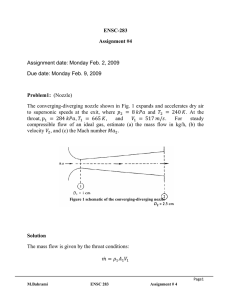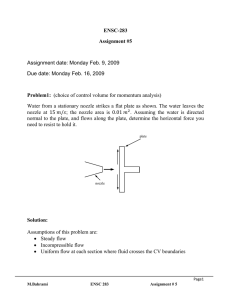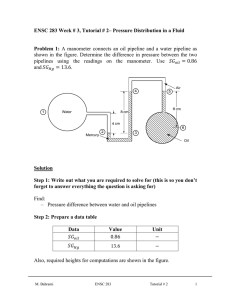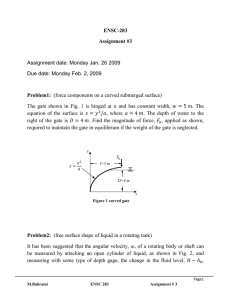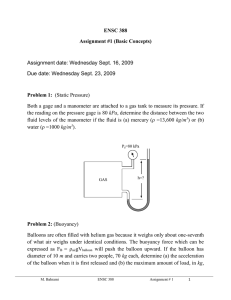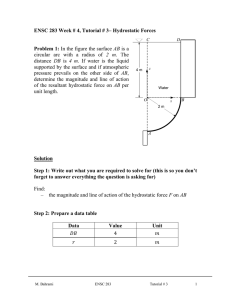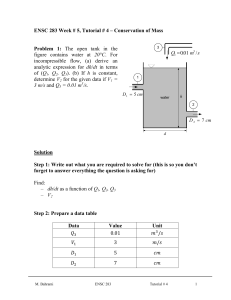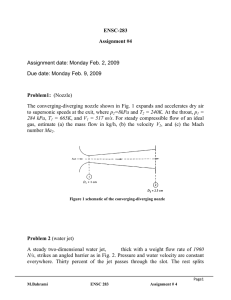Differential relations for fluid flow
advertisement
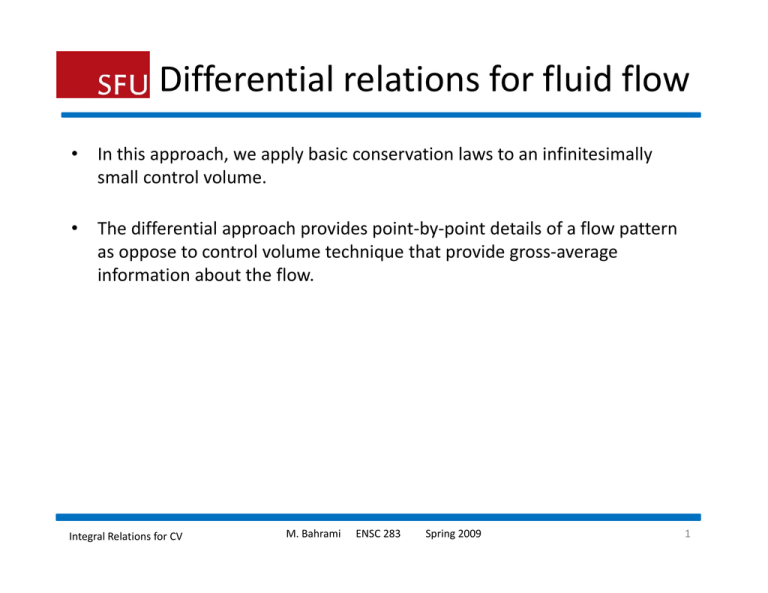
Differential relations for fluid flow • In this approach, we apply basic conservation laws to an infinitesimally small control volume. • The differential approach provides point‐by‐point details of a flow pattern as oppose to control volume technique that provide gross‐average pp q p g g information about the flow. Integral Relations for CV M. Bahrami ENSC 283 Spring 2009 1 Acceleration field of a fluid The Cartesian vector form of a velocity field in general is: The acceleration vector field can be calculated: The total acceleration vector: The total acceleration vector: Integral Relations for CV M. Bahrami ENSC 283 Spring 2009 2 Conservation of mass The conservation of mass for the element can be written as: Integral Relations for CV M. Bahrami ENSC 283 Spring 2009 3 Cylindrical polar coordinates The continuity equation in cylindrical coordinates become: Integral Relations for CV M. Bahrami ENSC 283 Spring 2009 4 Special cases For steady compressible flow, continuity equation simplifies to: FFor incompressible flow, continuity equation can be further simplified since i ibl fl ti it ti b f th i lifi d i density changes are negligible: Note: the continuity equation is always important and must always be satisfied y q y p y for a rational analysis of a flow pattern. Integral Relations for CV M. Bahrami ENSC 283 Spring 2009 5 Linear momentum equation In a Cartesian coordinates, the momentum equation can be written as: There are types of forces: body forces and surface forces. Body forces are due to external fields such as gravity and magnetism fields. We only consider gravity forces: Surface forces are due to the stresses on the sides of the control surface. These stresses are the sum of hydrostatic pressure plus viscous stresses which arise from the motion of the fluid. Integral Relations for CV M. Bahrami ENSC 283 Spring 2009 6 Stress tensor Unlike velocity, stresses and strains are nine‐component tensors and require two subscripts to define each component. The net surface force due to stresses in the x direction can be found as: The net surface force due to stresses in the x‐direction can be found as: Integral Relations for CV M. Bahrami ENSC 283 Spring 2009 7 Momentum equation cont’d. Similarly we can find the net surface force in y and z direction. After summing them up and dividing through by the volume: Therefore the linear momentum equation for an infinitesimal element Therefore the linear momentum equation for an infinitesimal element becomes: This is a vector equation, and can be written as: Integral Relations for CV M. Bahrami ENSC 283 Spring 2009 8 Special cases of momentum eq. Euler’s equation (inviscid flow), when the viscous terms are negligible: Navier‐Stoke equation (Newtonian fluid), For a Newtonian fluid, the viscous stresses are proportional to the element strain rates and the coefficient of viscosity. viscosity. For a Newtonian fluid with constant density and viscosity, we get: y y g Integral Relations for CV M. Bahrami ENSC 283 Spring 2009 9 Navier‐Stokes equation cont’d Incompressible flow Navier‐stokes equations with constant density. Navier‐Stokes equations have 4 unknowns: p, u, v, and w. They should be combined with the continuity equation to form four equations for theses unknowns. Navier‐Stokes equations have a limited number of analytical solutions; these equations typically are solved numerically using computational fluid dynamics (CFD) software and techniques. Integral Relations for CV M. Bahrami ENSC 283 Spring 2009 10 Angular momentum equation Application of the integral theorem to a differential element gives that the shear stresses are symmetric: Therefore there is no differential angular momentum equation Therefore, there is no differential angular momentum equation. Integral Relations for CV M. Bahrami ENSC 283 Spring 2009 11 Boundary conditions We have 3 equations to solve: i) continuity equation, ii) momentum, and iii) energy with 5 unknowns: ρ, V, p, u and T. We use data or algebraic expressions for state relations of thermodynamic We use data or algebraic expressions for state relations of thermodynamic properties such as ideal gas equation of state: Integral Relations for CV M. Bahrami ENSC 283 Spring 2009 12 Important boundary conditions At solid wall: Vfluid = Vwall (no‐slip condition) Tfluid = Twall (no‐temperature jump) At inlet or outlet section of the flow: V, p, T are known At a liquid‐gas interface: equality of vertical velocity across the interface (kinematic boundary condition) Mechanical equilibrium at liquid‐gas interface At a liquid‐gas interface: heat transfer must be the same Integral Relations for CV M. Bahrami ENSC 283 Spring 2009 13 Incompressible flow const properties Flow with constant ρ, μ, and k is a basic simplification that is very common in engineering problem that leads to: Continuity equation: Momentum equation: For frictionless or inviscid flows in which μ=0. The momentum equation reduces to Euler’s equation: q Integral Relations for CV M. Bahrami ENSC 283 Spring 2009 14
